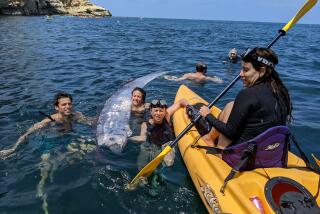Scrappy catch
- Share via
A hard-charging and delicious game fish is surging back from near oblivion as researchers repopulate the Southern California coast with white sea bass, offering anglers the thrill of some of the best fishing in decades.
The elusive white sea bass, a member of the croaker family, is a powerful fighter, weighing up to 80 pounds and spanning 5 feet. Gill nets began decimating the species in the 1950s, ruining the fishery for commercial as well as sport anglers. Sportfishing boats landed 65,545 fish in 1949, but 40 years later, anglers’ hauls had fallen to barely 1,000 sea bass annually. Regulators set quotas, banned gill nets from coastal and island waters and started a novel recovery program nearly 20 years ago.
The Hubbs-Sea World Research Institute, working with the state Department of Fish and Game, launched the Ocean Resources Enhancement Hatchery Program to raise juvenile white sea bass in pens from Santa Barbara to San Diego and release them into the ocean.
The $19-million project will have placed 1 million juvenile fish into coastal waters once the next load, scheduled to be released this fall, is turned out. A $3.50 stamp anglers purchase with a fishing license has raised $13.5 million for the program, and environmental remediation funds from utility and oil companies provided $5.4 million.
The project is the marine manifestation of a terrestrial trend toward replenishment of animal populations decimated by human activity.
Land-based captive-breeding programs have returned peregrine falcons and California condors to the West.
The pioneering sea bass program grows fish bred from wild sea bass in a hatchery and doesn’t release them into the ocean until they reach 12 inches in length -- big enough to survive and eventually mate with wild fish.
Scientists can track many fish by scanning a microchip embedded in their heads.
Linda Chaves, aquaculture coordinator for the National Oceanographic and Atmospheric Administration, says the fish tracking system makes the program a potential model for federal projects.
“It’s the only way we can figure out if it’s having a positive impact on the stock,” Chaves says. “We think this kind of research in conjunction with a traditional fisheries management approach can go hand in hand to help bring back depleted resources.”
Anglers play a big role, providing volunteer labor at hatchery pens and release sites.
Earlier this summer, the Millie G slid into Newport Harbor at twilight to unload 6,000 small, white sea bass. Fishermen watched the silvery mass proudly.
“Why am I doing this? Because I want more fish for my kids,” says Jimmy Decker, 46, a Balboa Angling Club volunteer from Newport Beach. “I’ve got three kids and when they’re my age, hopefully there will still be sea bass to be caught.”
A lack of money threatens the program, scientists warn. Fishing license sales will probably bring in $500,000 less than the program needs, and unless someone kicks in more money, scientists may have to release fewer fish next year.
For now, the white sea bass fishery is well along the road to recovery. This year, researchers expect to release 250,000 tagged fish -- the most in a single year.
Anglers have caught nearly 1,000 tagged fish since the program released the first batch in 1986. In April, a fisherman caught a 25-pound tagged fish -- the largest and oldest captive-bred fish to date -- at Santa Catalina Island. The fish was released off Santa Barbara in 1995.
Meanwhile, the long-term trend is toward steadily increasing sportfishing catches. Anglers have caught an average of 36,000 white sea bass annually over the last three seasons, according to officials.
As more fish are released and grow into adults, scientists say the best white sea bass fishing in nearly 50 years is yet to come.
“We can factually state that hatchery fish are contributing to the wild stock -- even with modest releases prior to 2000,” says Mark Drawbridge, a senior biologist at Hubbs-Sea World.
Because it usually takes five years for sea bass to reach legal size, 28 inches, fishermen can probably count on more and more battles with the scrappy fish -- and more sea bass dinners -- in the next few years, he says.
More to Read
Sign up for Essential California
The most important California stories and recommendations in your inbox every morning.
You may occasionally receive promotional content from the Los Angeles Times.










